Latest Posts by ritasakano - Page 2
Quando o falar não se faz necessário
Quando o olhar completa as palavras
Quando o toque confessa
Tudo o que somos
Rita Sakano

Outubro
Primavera no hemisfério sul
Cores e perfumes
Alegram
Os dias ensolarados
Iluminam os meus olhos
Saudade dos meus amores.
Outubro 2020


Al poseerse, los amantes dudan. No saben ordenar sus deseos. Se estrechan con violencia, se hacen sufrir, se muerden con los dientes los labios, se martirizan con caricias y besos. Y ello porque no es puro su placer, porque secretos aguijones los impulsan a herir al ser amado, a destruir la causa de su dolorosa pasión. Y es que el amor espera siempre que el mismo objeto que encendió la llama que lo devora, sea capaz de sofocarla. Pero no es así. No. Cuanto más poseemos, más arde nuestro pecho y más se consume. (…) No basta la visión del cuerpo deseado para satisfacerlos, ni siquiera la posesión, pues nunca logran desprender ni un ápice de esas graciosas formas sobre las que discurren, vagabundas y erráticas, sus caricias.
Al fin, cuando, los miembros pegados saborean la flor de su placer, piensan que su pasión será colmada, y estrechan codiciosamente el cuerpo de su amante, mezclando aliento y saliva, con los dientes contra su boca, con los ojos inundando sus ojos, y se abrazan una y mil veces hasta hacerse daño. Pero todo es inútil, vano esfuerzo, porque no pueden robar nada de ese cuerpo que abrazan, ni penetrarse y confundirse enteramente cuerpo con cuerpo, que es lo único que verdaderamente desean: tanta pasión inútil ponen en adherirse a los lazos de Venus, mientras sus miembros parecen confundirse, rendidos por el placer.
Y después, cuando ya el deseo, condensado en sus venas, ha desaparecido, su fuego interrumpe su llama por un instante, y luego vuelve un nuevo acceso de furor y renace la hoguera con más vigor que antes. Y es que ellos mismos saben que no saben lo que desean y, al mismo tiempo, buscan cómo saciar ese deseo que los consume, sin que puedan hallar remedio para su enfermedad mortal: hasta tal punto ignoran dónde se oculta la secreta herida que los corroe.
La herida oculta - Lucrecio En «Dē rērum natūra» (De la naturaleza de las cosas) Versión de Luis Alberto de Cuenca
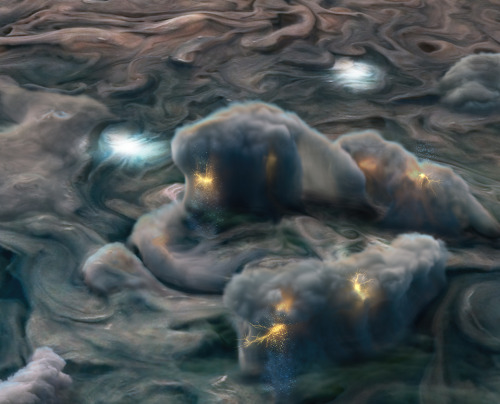
New results from our Juno mission suggest the planet is home to “shallow lightning.” An unexpected form of electrical discharge, shallow lightning comes from a unique ammonia-water solution.
It was previously thought that lightning on Jupiter was similar to Earth, forming only in thunderstorms where water exists in all its phases – ice, liquid, and gas. But flashes observed at altitudes too cold for pure liquid water to exist told a different story. This illustration uses data obtained by the mission to show what these high-altitude electrical storms look like.
Understanding the inner workings of Jupiter allows us to develop theories about atmospheres on other planets and exoplanets!
Illustration Credit: NASA/JPL-Caltech/SwRI/MSSS/Gerald Eichstädt/Heidi N. Becker/Koji Kuramura
Make sure to follow us on Tumblr for your regular dose of space: http://nasa.tumblr.com
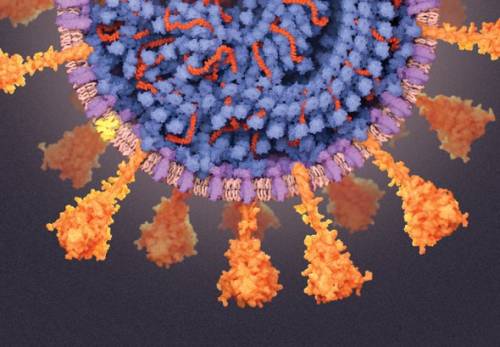
A Visual Guide to the SARS-CoV-2 Coronavirus
Illustrations by Veronica Falconieri Hays (Scientific American)
What scientists know about the inner workings of the pathogen that has infected the world
For all the mysteries that remain about the novel coronavirus and the COVID-19 disease it causes, scientists have generated an incredible amount of fine-grained knowledge in a surprisingly short time.
Thousands of different coronaviruses may inhabit the planet. Four of them are responsible for many of our common colds. Two others have already triggered alarming outbreaks of disease: in 2002 a coronavirus caused severe acute respiratory syndrome (SARS), which killed more than 770 people worldwide, and in 2012 a different strain started Middle East respiratory syndrome (MERS), taking more than 800 lives. SARS burned out within a year; MERS still lingers.
The newest coronavirus, SARS-CoV-2, has created a far deadlier pandemic in part because once it infects a person it can lie undetected for a long time. An individual who had the SARS coronavirus did not transmit it until 24 to 36 hours after displaying symptoms such as fever and dry cough; people feeling ill could be isolated before they made others sick. But people with COVID-19 can transmit the virus before they show clear symptoms. Not feeling ill, infected men and women work, commute, shop, eat out and attend parties, all the while exhaling coronavirus into the airspace of people around them. The virus can remain undetected inside the human body for so long partly because its genome produces proteins that delay our immune system from sounding an alarm. Meanwhile lung cells die as the virus secretly reproduces. When the immune system does hear the call, it can go into overdrive, suffocating the very cells it is trying to save.
In the graphics that follow, Scientific American presents detailed explanations, current as of mid-June, into how SARS-CoV-2 sneaks inside human cells, makes copies of itself and bursts out to infiltrate many more cells, widening infection. It shows how the immune system would normally attempt to neutralize virus particles and how CoV-2 can block that effort. It explain some of the virus’s surprising abilities, such as its capacity to proofread new virus copies as they are being made to prevent mutations that could destroy them. And it shows how drugs and vaccines might still be able to overcome the intruders.

Virus invasion and immune response
A SARS-CoV-2 particle enters a person’s nose or mouth and floats in the airway until it brushes against a lung cell that has an ACE2 receptor on the surface. The virus binds to that cell, slips inside and uses the cell’s machinery to help make copies of itself. They break out, leaving the cell for dead, and penetrate other cells. Infected cells send out alarms to the immune system to try to neutralize or destroy the pathogens, but the viruses can prevent or intercept the signals, buying time to replicate widely before a person shows symptoms.





Drug and vaccine intervention
Commercial and university labs are investigating well over 100 drugs to fight COVID-19, the disease the SARS-CoV-2 virus causes. Most drugs would not destroy the virus directly but would interfere with it enough to allow the body’s immune system to clear the infection. Antiviral drugs generally stop a virus from attaching to a lung cell, prevent a virus from reproducing if it does invade a cell, or dampen an overreaction by the immune system, which can cause severe symptoms in infected people. Vaccines prepare the immune system to quickly and effectively fight a future infection.


The remarkable and mysterious Coronavirus genome
The SARS-CoV-2 genome is a strand of RNA that is about 29,900 bases long—near the limit for RNA viruses. Influenza has about 13,500 bases, and the rhinoviruses that cause common colds have about 8,000. (A base is a pair of compounds that are the building blocks of RNA and DNA.) Because the genome is so large, many mutations could occur during replication that would cripple the virus, but SARS-CoV-2 can proofread and correct copies. This quality control is common in human cells and in DNA viruses but highly unusual in RNA viruses. The long genome also has accessory genes, not fully understood, some of which may help it fend off our immune system.

This article was originally published with the title “Inside the Coronavirus” in Scientific American 323, 1, 32-37 (July 2020). doi:10.1038/scientificamerican0720-32
Source: By Mark Fischetti, Veronica Falconieri Hays, Britt Glaunsinger, Jen Christiansen | Scientific American July 2020 Issue
Lindas imagens!
The Beautiful Things inside Your Head: Winners of the 10th Annual Art of Neuroscience Contest
Winner: Lidija Kononenko

Artist Kononenko described this interactive piece as “a microscope specimen, a map of symptoms, and an investigation of the unknown” in a statement accompanying it. Viewers can zoom in and explore the details of a microscope image of the peripheral nerve system, which is overlaid by textual facts and poetic phrases about sleep.Sleep is “a voluntary act of losing one’s own consciousness,” Konenenko explained in her statement. The poetic snippets resemble the fragmented thoughts humans have while falling asleep. And zooming in and out of the image represents the transition between wakefulness and sleep. Additionally, 31-3594 allows the viewer to act as a pathologist, achieving the goal of blending neuroscience and art. In assessing this unique piece, the jurors praised it for “the interactivity and playful combination of imagery of a human peripheral nerve with a text-based story that unfolds at various scales and highlights the role of the nervous system in the human condition.”
Honorable Mentions

Red Haze by Nicki Coveña
A tsunami of red dots dominates this image by neuroscientist Coveña. The bright red color comes from a fluorescent protein, which was used to visualize the workings of TBR1—a gene that synthesizes the protein that regulates the information transfer from DNA to messenger RNA in vertebrate embryo development. “The out-of-focus view makes one guess at what details are hidden below,” the jurors wrote.

Motor White Matter Networks of the Human Brain by Sanja Budisavljevic
In this piece, neuroscientist Budisavljevic superimposed color onto a 19th-century black-and-white drawing of a brain based on a postmortem dissection. Each color indicates a different “highway,” or white matter pathway connecting particular regions of gray matter and allowing information to be transferred. Red indicates the most prominent highway, which links the cortex and spinal cord. “This pathway carries the messages to and from the body and allows us to function in our sensory world,” Budisavljevic says. Green represents the connection that supports coordination, and blue shows the one that regulates movements.

Bdl by Paméla Simard (Alex Tran, photographs)
Artist Simard partnered with Hunter Shaw, a neuroscientist then at McGill University, to create a series of delicate wooden sculptures. “The various installations were created from fluorescent microscopy images representing the visual system of the fruit fly brain,” Simard wrote in her statement. The intricate details of the fruit fly visual system were made possible by first laminating the thin slices of different types of wood together, then hand cutting the result to mimic the microscope images.
More Art from 2020 Gallery

Whale Retina Rainbow by Elena Vecino Cordero and Luis López Vecino
In February 2019 the death of a whale in Sopelana Beach in Spain made the local news. The beach happened to be close to the University of the Basque Country, where biologist Vecino Cordero works. Seizing the opportunity, she and some volunteers extracted the eye of the whale and took it back to her ophthalmology research group for further study. The image was produced as a part of their research. The whale’s retina was imaged using scanning electron microscopy. And later López Vecino added the colors using Adobe Photoshop.

Sensing Spin by Dan Jagger
Physiologist Jagger used a high-resolution microscope to capture this image. It shows mechanosensory hair cells located in the inner ear that play a role in the sense of balance. A protein called actin is within bundles of stereocilia and is stained yellow. Actin helps the bundles to stand upright, so when the human head turns, they can detect the movement of the fluid they are immersed in. The hair-cell nuclei are stained with cyan.

The Protection of Nature Starts in Our Mind by Robert Luck
Luck is a neuroscientist at Heidelberg University in Germany who studies the development of the cerebellum, located where the spinal cord meets the brain. Alarmed by climate change and deforestation, he created a “mind forest” that resembles bird’s-eye-view photographs of real forests. The “trees” are 65 individually traced images of mice’s Purkinje neurons, which play important roles in controlling coordination and movements. “I chose the number 65 to represent the number of years needed for the rainforest to regrow and gain back at least 80% of its diversity,” Luck wrote in his statement. “[Sixty-five] years—a human lifetime!”

Memories and Patterns: Oligodendrocytes by Shanthi Chandrasekar
Oligodendrocytes are glial cells that support and insulate long neuronal axons. The cells’ lipid membrane wraps around the axons to strengthen the structure, as well as to help neurons to send signals quickly. “A single oligodendrocyte can connect with multiple axons,” artist Chandrasekar wrote in her statement. “In this [pen-and-ink] drawing, I have tried to bring out the connectedness of the oligodendrocytes and the axons.”

Shelter in Place by Geinene Carson
As its title suggests, this piece represents “the artist’s interpretation of the pandemic experience” while sheltering in place because of COVID-19, according to artist Carson’s statement. This acrylic-on-canvas piece is a part of a series entitled Neuron, which started as “visual prayers for our daughter with a rare genetic disorder,” Carson wrote on her Web site. While Shelter in Place implies physical restrictions, Carson, who is based in Atlanta, draws inspiration from the neural network, “because as important as our physical surroundings are to our state of living, our thought life holds the key to thriving within whatever the circumstances may be,” she wrote.

Bridges between Genesis and Neuroscience: Triplets by Rui Rodrigues
This image features three neurospheres—clusters of neural stem or progenitor cells—that are similar in size and shape. Because of their similarity, neurobiologist Rodrigues entitled the piece Triplets. The vibrant colors come from “antibodies coupled with fluorescent tags to label specific proteins,” he says.

The Transfer by Geinene Carson

Motor Neuron Architectural Digest by Stefanie Hauck - University of Bonn

Illuminating The Vascular Network - EPFL by Marwan Abdellah

Futon de algodão e um mimo para o neto!!
Colcha de retalho
Início sempre tem seus cortes tortos, mesmo que se use régua e cortador, parece que a mão gosta de dar outro contorno aos cortes.
Colcha de retalho é cheia de lembranças, conta histórias perdidas no tempo e deixa no presente a satisfação de fazer, para o futuro a certeza que a história continua.













“Throwback 2019”
Visit Instagram Profile > Hisa instagram

Maurice Utrillo’s Paris Street, 1914 (via here)
Whale automata by Sylvain Gautier.
The Island Named After a Satellite
It is so small that you cannot see it on Google maps. It measures 25 by 45 meters (27 by 49 yards), about half the size of a football field. This barren bit of rock off the coast of Canada also has an unusual namesake: the Landsat 1 satellite. The small size is actually what made the island notable in 1973, when it was initially discovered. Well, that, and the polar bear trying to eat one of the surveyors.
Betty Fleming, a researcher with the Topographic Survey of Canada, was hunting for uncharted islands and rocks amidst data from the new Landsat 1 satellite. She was particularly interested in the new satellite’s ability to find small features. Working with the Canadian Hydrographic Service, Fleming scanned images of the Labrador coast, an area that was poorly charted. About 20 kilometers (12 miles) offshore, the satellite detected a tiny, rocky island. Surveyors were sent to verify the existence of the island and encountered a hungry polar bear on the island. The surveyor quickly retreated. Eventually, the island became known as “Landsat Island,” after the satellite that discovered it. Watch the video to learn more about Betty Fleming and how Landsat Island was discovered by satellite and ground surveyors.
For more details about Landsat Island, read the full stories here:
The Island Named After a Satellite
The Unsung Woman Who Discovered an Unknown Island
Make sure to follow us on Tumblr for your regular dose of space: http://nasa.tumblr.com.
Why are some insects so shiny and iridescent?
First here’s a post I answered on HOW insects form shiny or iridescent exoskeletons. It’s always good to know the answer to how because it can give context to the why. So why are some insects iridescent or shiny?
This can be split into two main categories; communicative functions and non-communicative.
COMMUNICATION
1. Mate Selection
While insects tend to use chemical communication more as a means of attracting potential mates colouration can however play a significant role in mate selection in a number of ways.
Honest signalling - in which the colouration reveals the quality of the individual as these colourations are costly to produce. Therefore only individuals that are high-quality are able to afford the cost of producing these signals (in this case the iridescence or shiny colouration)
Example:
A study (Fitzstephens & Getty, 2000) found that male Calopteryx maculata (Black-winged damselfly) with higher fat stores had a much bluer iridescent colouration compared to males on low fat diets.

Amplifier traits - iridescent / shiny colours may be used to amplify the differences in the signals of quality (however no studies have directly focused if this is a function of iridescence)
Sensory drives - iridescent colouration was favoured due to being more effective in signalling in certain ecological environments
Receiver Bias - females (or in rare cases the males or hermaphrodites) as the receivers may have favoured certain iridescent colouration due to being better received by their sensory system therefore resulting in the evolution of this colouration
2. Species Recognition
Man species use iridescent / shiny colouration in order to identify members of their own species! As simple as that!
Example:
Colias eurytheme (orange sulfur butterfly) use UV iridescence to communication with conspecifics

3.Agonistic interactions
Iridescense / shiny colouration may be used in intrasexual encounters; mostly male-male agonistic encounters and can be used as a territorial signal.
4.flocking behaviour
Can help insects that school together facilitate their orientation or direction within their schools / flocks. This is seen in many aquatic species of fish and even squid.
5. Predation avoidance
Iridescense / shiny colouration can be used to order to actually avoid predation! Although at first glance you’d assume this would make them more visible, this isn’t always the case.
Mimicry / camouflage - insects can avoid predation by mimicking objects, leaves, raindrops, other harmful species or even by blending into the background
Examples:
A number of iridescent jumping spider species (Salticidae); such as Brettus adonis in this study (Jackson & Hallas 1986) were found to mimic raindrops to avoid predation

The iridescent green leaf beetles such as the (Dogbane Leaf Beetle, Chrysochus auratus) similarity use their iridescence colouration to mimic dew on leaves.

Species like tiger beetles ( Cicindelinae) even use their iridescence to create an unsaturated appearance that allow them to blend into their envrionment (Schultz 1986, 2001)

Warning colouration - insects may use their colouration to communicate their toxicity or unpalatability serving as aposematic warning.
Example:
Panamanian tortoise beetle (Charidotella egregia) that change from gold to red when disturbed by predators(Vigneron et al. 2007).

Startle displays - some species will use their iridescence colouration to create a flash that may startle potential predators long enough for them to escape due to the way in which the iridescence reflects light.
Example:
The tiger beeltes again! Some of them have bright colouration like below that they use as startle defenses against predators (Sargent 1990).

NON-COMMUNICATION
1. Thermoregulation
There’s much debate over whether Iridescense / shiny colouration has any function in either heat absorption or dispersion.
Some found evidence that the structures used to created iridescense / shiny colouration acted as heat collectors, like in the wings of butterflies ( Miaoulis & Heilman 1998). However other’s have found no evidence of thermoregulation in tiger beetles Schultz & Hadley (1987).
2.Friction reduction
iridescense structures may reduce the friction in burrowing insects
Example: Carabid Beetles (Brachininae) (Seago et al. 2009).

These are just some of the proposed and studied functions of iridescense and shiny colouration in insects, there are more that aren’t as well studied or understood just yet!
More reading:
Doucet S, Meadows M 2009, ‘Iridescence: a functional perspective’, Journal of the Royal Society Interface, vol.6, no.2, pp.115–132
Meadows M, Butler M, Morehouse N, Taylor L, Toomey M, McGraw K, Rutowski R 2009, ‘Iridescence: views from many angles’, Journal of the Royal Society Interface, vol.6, pp.203–211
Meet ZUtA, the pocket printer that solves all of your on-the-go printing needs. 🖨

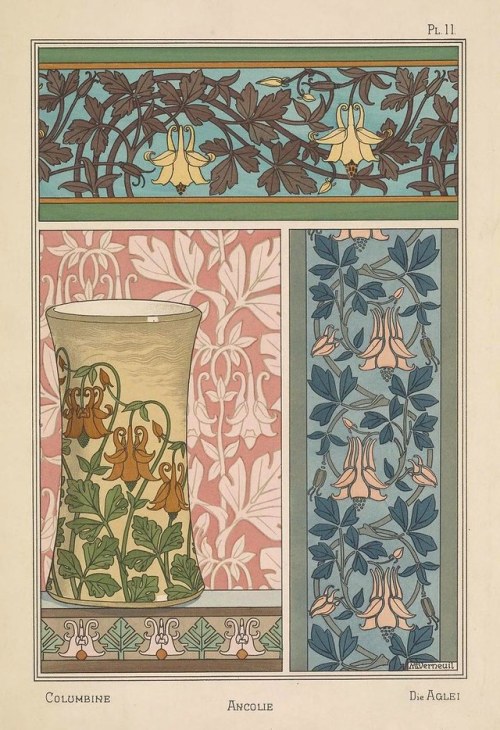
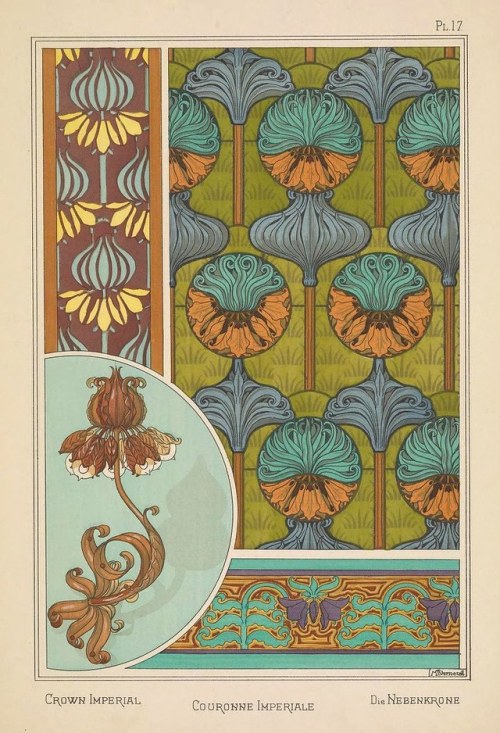
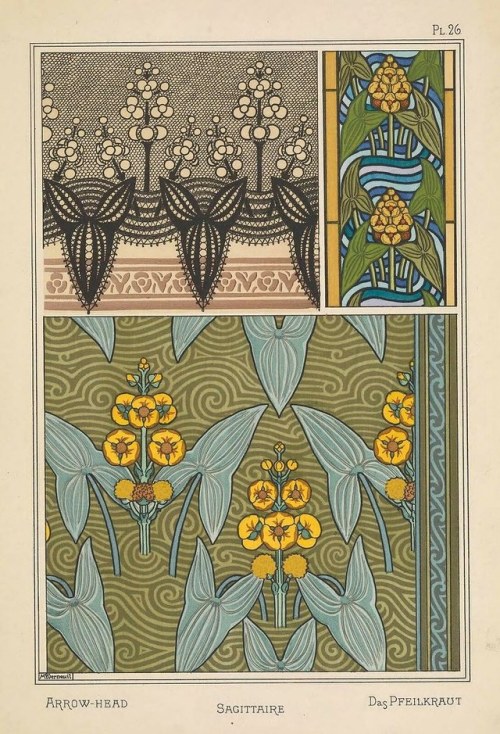

Eugène Grasset, Plants and Their Application to Ornament, 1896
Archive.org and Gallica.bnf.f
My brother and I saw this precious little rat snake watching everyone gardening in my grandparents’ yard. How could anyone hate this sweet curious face? I was cooing at him for like 20 minutes ♥️


What’s your job? Tell us in Japanese!
Our PDF lessons are a great way to help you master survival Japanese. Why not give them a try for free? https://www.japanesepod101.com/?src=social_occupation_words_092818

Tristeza! Muito descaso com a Ciência no Brasil!!
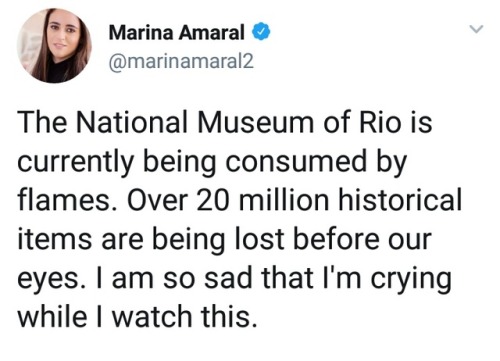







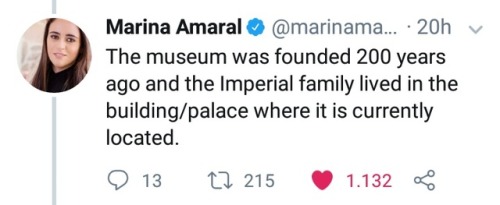
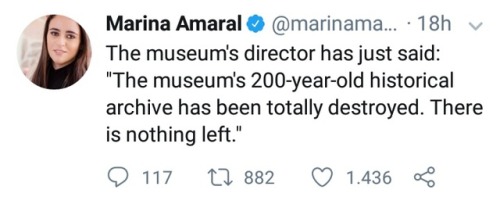
















This happened yesterday in Brazil and I’m from Mexico, but this is a major tragedy and loss to science, culture and humanity.😢💔 (source)
Modesto Carvalhosa on Twitter
“Pauta do Congresso agora é vingança contra MP e Judiciário”, diz procurador - O Antagonista

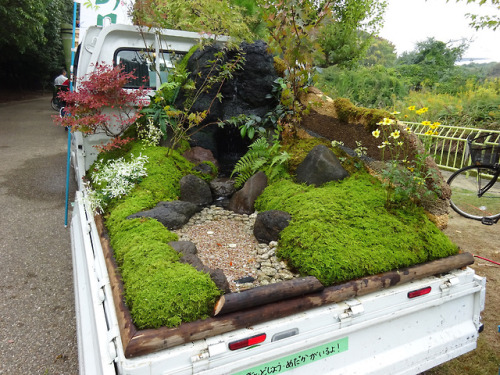

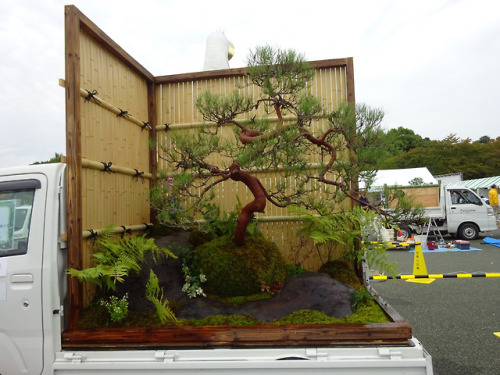
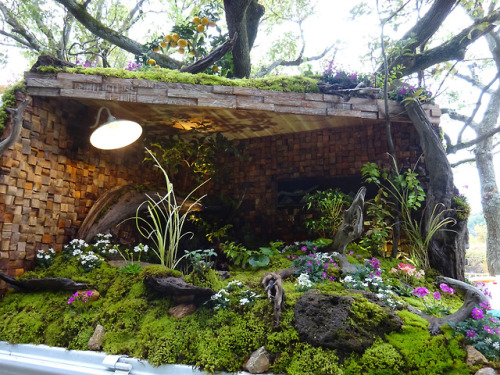
The Japanese Mini Truck Garden Contest is a Whole New Genre in Landscaping


Over geological timescales – on the order of millions of years – even hard substances like rock can flow like a fluid. Heat from the Earth’s core drives convection inside our mantle, and that fluid motion ultimately drives the plate tectonics we experience here at the surface. But most other planetary bodies, including those with mantle convection similar to ours, don’t have a surface that shifts like our tectonic plates. Mars and Venus, for example, have solid, unmoving surfaces. The images above provide a peek at what goes on beneath. The upper image shows a simulation of mantle convection inside Mars over millions of years. The lower image is a timelapse of dye convecting through a layer of glucose syrup being heated from below. Notice how both examples show evidence of convective cells and plumes that help circulate warm fluid up and colder fluid downward. (Image credit: Mars simulation - C. Hüttig et al, source; N. Tosi et al., source; submitted by Nicola T.)